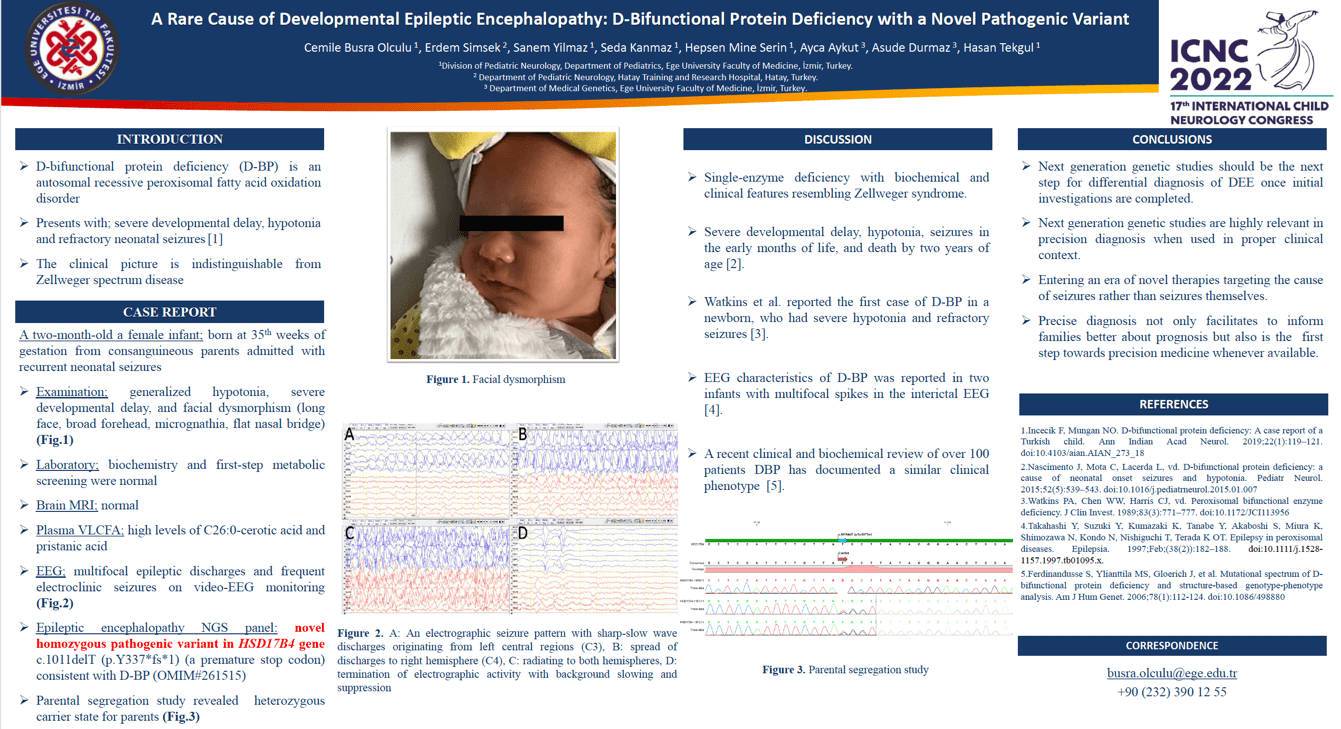A Rare Cause of Developmental Epileptic Encephalopathy: D-Bifunctional Protein Deficiency with a Novel Pathogenic Variant
Cemile Busra Olculu, Erdem Simsek, Sanem Yilmaz, Seda Kanmaz, Hepsen Mine Serin, Ayca Aykut, Asude Durmaz, Hasan Tekgul
Objectives: D-bifunctional protein deficiency (D-BP) is a rare autosomal recessive peroxisomal fatty acid oxidation disorder. In the vast majority of cases with D-BP, the clinical presentation is very severe, with hypotonia and refractory neonatal seizures, resembling Zellweger spectrum disorders. With the development of new genetic analyses, there is an increase in infants with neonatal seizures who are definitely diagnosed with genetic and metabolic etiologies. Our aim is to demonstrate the importance of the definitive diagnosis of this rare disease by genetic analysis, which is difficult to distinguish clinically from other peroxisomal diseases. Methods: We present a female infant with early epileptic encephalopathy who give rise to deep global hypotonia after the neonatal period. Results: First-step metabolic screening did not indicate an inborn error of metabolism in a hypotonic infant with refractory focal motor seizures. In a series of electroencephalography studies, multifocal epileptic discharges and electroclinic seizures were observed, suggesting epileptic encephalopathy (Figure1). The analysis of plasma very long chain fatty acids and panel of epileptic encephalopathy provided a diagnosis of peroxisomal disorder (D-BP) with a novel mutant gene (homozygous c.1011delT (p.Y337*fs*1) (OMIM#261515) pathogenic variant resulting in a premature stop codon in the HSD17B4 (NM_000414.4) gene). Conclusions: Next-generation genetic studies are essential in identifying subtypes of peroxisomal disorders because they have similar very-long-chain fatty acid levels and dysmorphic findings. Though not always the correct genetic diagnosis helps with treatment, it facilitates informing the families better about prognosis, family counseling, and future prenatal diagnosis.
Keywords: Epileptic encephalopathy, peroxisomal disorders, D-Bifunctional Protein Deficiency
Cemile Busra Olculu
Ege University Medical Faculty
Turkey
Erdem Simsek
Hatay Training and Research Hospital
Turkey
Sanem Yilmaz
Ege University Medical Faculty
Turkey
Seda Kanmaz
Ege University Medical Faculty
Turkey
Hepsen Mine Serin
Ege University Medical Faculty
Turkey
Ayca Aykut
Ege University Faculty of Medicine
Turkey
Asude Durmaz
Ege University Faculty of Medicine
Turkey
Hasan Tekgul
Ege University Medical Faculty
Turkey
Objectives: D-bifunctional protein deficiency (D-BP) is a rare autosomal recessive peroxisomal fatty acid oxidation disorder. In the vast majority of cases with D-BP, the clinical presentation is very severe, with hypotonia and refractory neonatal seizures, resembling Zellweger spectrum disorders. With the development of new genetic analyses, there is an increase in infants with neonatal seizures who are definitely diagnosed with genetic and metabolic etiologies. Our aim is to demonstrate the importance of the definitive diagnosis of this rare disease by genetic analysis, which is difficult to distinguish clinically from other peroxisomal diseases. Methods: We present a female infant with early epileptic encephalopathy who give rise to deep global hypotonia after the neonatal period. Results: First-step metabolic screening did not indicate an inborn error of metabolism in a hypotonic infant with refractory focal motor seizures. In a series of electroencephalography studies, multifocal epileptic discharges and electroclinic seizures were observed, suggesting epileptic encephalopathy (Figure1). The analysis of plasma very long chain fatty acids and panel of epileptic encephalopathy provided a diagnosis of peroxisomal disorder (D-BP) with a novel mutant gene (homozygous c.1011delT (p.Y337*fs*1) (OMIM#261515) pathogenic variant resulting in a premature stop codon in the HSD17B4 (NM_000414.4) gene). Conclusions: Next-generation genetic studies are essential in identifying subtypes of peroxisomal disorders because they have similar very-long-chain fatty acid levels and dysmorphic findings. Though not always the correct genetic diagnosis helps with treatment, it facilitates informing the families better about prognosis, family counseling, and future prenatal diagnosis.
Keywords: Epileptic encephalopathy, peroxisomal disorders, D-Bifunctional Protein Deficiency
Cemile Busra Olculu
Ege University Medical Faculty
Turkey
Erdem Simsek
Hatay Training and Research Hospital
Turkey
Sanem Yilmaz
Ege University Medical Faculty
Turkey
Seda Kanmaz
Ege University Medical Faculty
Turkey
Hepsen Mine Serin
Ege University Medical Faculty
Turkey
Ayca Aykut
Ege University Faculty of Medicine
Turkey
Asude Durmaz
Ege University Faculty of Medicine
Turkey
Hasan Tekgul
Ege University Medical Faculty
Turkey

Cemile Busra Olculu
Ege University Medical Faculty Turkey
Ege University Medical Faculty Turkey